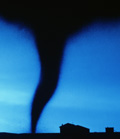 About F&D Subscribe Back Issues Write Us Copyright Information Free Email Notification Receive emails when we post new
items of interest to you. |
From the Editor A couple of years into the new millennium, it is reasonable for us to wonder if the financial turbulence experienced in emerging market economies since the mid-1990s, with its tremendous economic and social costs, will continue. Crises in Turkey in 2001 and Argentina in 2001-02, following those in Mexico in 1994-95, East Asia in 1997-98, Russia in 1998, and Brazil in 1998-99, lead us to ask if the international community is making any progress in preventing such disasters and in resolving those that do occur more quickly and less painfully. Surely, we must have learned a great deal by now. What hope can we—especially the IMF—offer emerging market economies and those countries positioning themselves to participate in the world of international capital flows? And what more have we learned about what those countries themselves should do to avoid trouble? This issue of Finance & Development explores these questions in a series of articles, "Facing Crises." One message is that we are indeed gaining insights into the causes of crises and, thus, how we might better prevent them. As a result, new efforts are under way. For example, since mid-2001, the IMF has been conducting internally assessments of country vulnerabilities on a more regular and formal basis. And early warning systems based on econometric techniques, which staff have been working on since the Mexican crisis, are providing additional information on where vulnerabilities may lie. However, another message of these articles is how low we still are on the learning curve, in relation to where we'd like to be. In his column Straight Talk, Kenneth Rogoff, the IMF's Economic Counsellor and Research Department Director, picks up on a key question that needs more study: given a country's financial system and macroeconomic situation, at what point do the benefits of further capital market integration exceed the costs? In the meantime, he says, the international community should keep "an open mind but not a blind eye on the issue of capital controls and debt—especially when debating ways to better immunize the global financial system against crises in the twenty-first century." * * * * * Also in this issue, the IMF's Independent Evaluation Office, established in 2001, reports on its first study: an examination of why some countries have been borrowing repeatedly from the IMF, and of when this can be harmful. Its recommendations, currently being debated by the IMF's 184 member countries, include being more transparent about the extent to which political factors feed into loan decisions and finding other ways—besides granting a loan—for the IMF to signal its approval of a country's economic program. How corruption can thwart progress in reducing poverty is examined in the Picture This section, where some notable IMF research is presented in a series of charts. Another intriguing topic, which has acquired new meaning since the terrorist attacks of September 2001 in the United States, is the tracking of terrorist financing. The magazine takes a look at what governments should do about the system known as "hawala"—a traditional, informal method of transferring money between countries that is being scrutinized for its alleged role in financing terrorism and other illegal activities.
Laura Wallace |